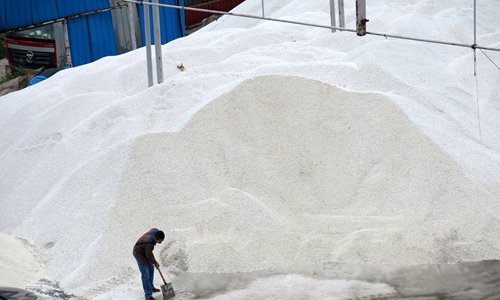China's rare-earth firm moves from foreign-dependent to self-reliant
By Yin Yeping Source:Global Times Published: 2020/6/2 19:02:44
Rare-earth firm moves from foreign-dependent to self-reliant

A worker unloads rare earths along the Yangtze River's banks in Southwest China's Chongqing Municipality. Photo: IC
China's leading rare-earth supplier is speeding up construction of production facilities for ceria-zirconia solid solution that are expected to open in September. Experts said the development shows that China's rare-earth ceria-zirconia solid solution technology has broken international monopoly.
China Northern Rare Earth (Group) High-Tech Co - which is under the country's largest light rare-earth producer Baogang Group - in Baotou, North China's Inner Mongolia Autonomous Region is stepping up construction of the new production line, which will make 500 tons of ceria-zirconia solid solution a year, according to a report that the company sent to the Global Times on Tuesday.
This new facility is expected to help the company move away from its traditional model of extracting and selling ore toward more advanced production.
For a long time, enterprises from Japan, France and the Netherlands have held 70 percent of the international market for ceria-zirconia solid solution, and domestic producers have been wholly foreign-owned, industry analysts said.
Once the production line is in place, the specific surface area (SSA), a physical value that can be used to determine the type and properties of a material, of the ceria-zirconia solid solution turned out by the new facility will be 5 percent higher than that of the current products made by some foreign enterprises, the company said in its report.
The Global Times learned that the price of ceria as a raw material is only 13,000 yuan ($1,830) per ton, but the price of high value-added products is 130,000 yuan per ton.
The production technology used to make ceria-zirconia solid solution can also convert vehicle emissions into carbon dioxide, water and nitrogen through chemical reactions.
So far, four or five environmental protection enterprises in the vehicle sector have contacted the company about cooperation.
Zhou Hongchun, research fellow with the Development Research Center of the State Council, China's cabinet, told the Global Times that this technology is not particularly new or cutting-edge, but it's another case of long-standing reliance on foreign suppliers.
"This long-time dependence on foreign countries has changed partially because of the repression of the US," Zhou said. "In order to ensure the safety of the industry chain, we should independently carry out research and development, and seek a new way out."
After breaking the foreign technology monopoly and forming independent intellectual property rights and domestic patents, large-scale production can be expected, Zhou said.
China Northern Rare Earth (Group) High-Tech has a resource advantage and competitive prices that after the production line is in place, the products by the new facility will soon attract manufacturers of environmentally friendly vehicle equipment, the report said.
Newspaper headline: Rare-earth firm moves from foreign-dependent to self-reliant